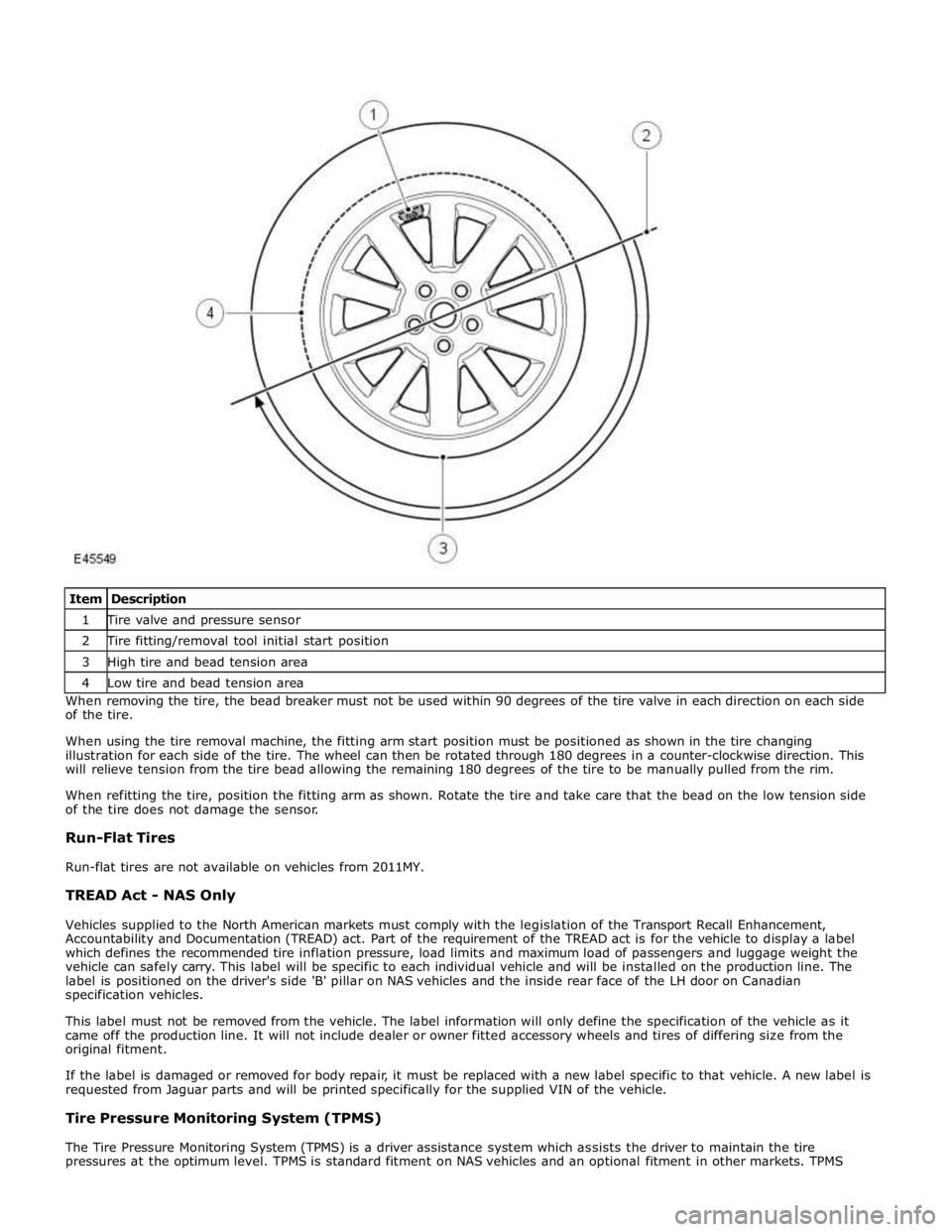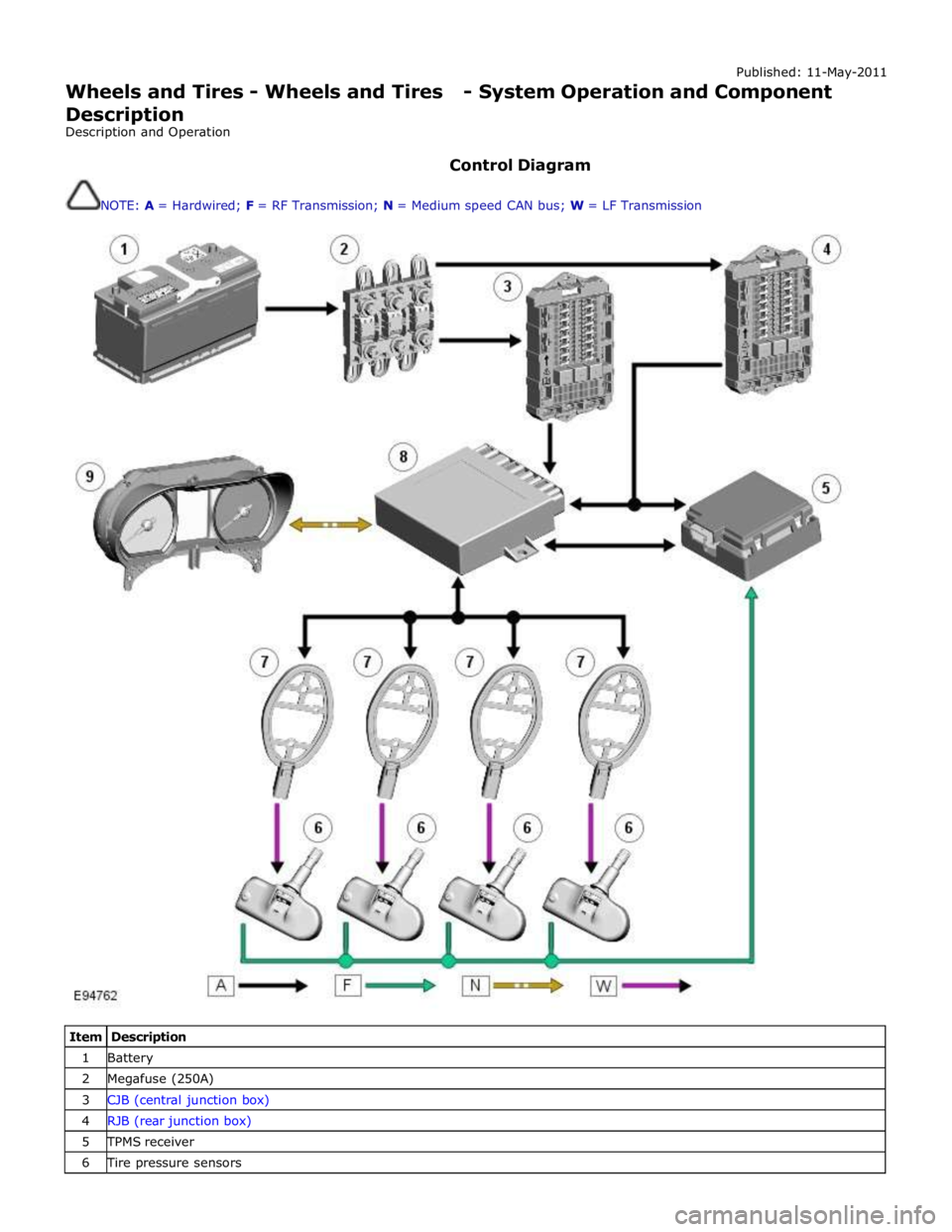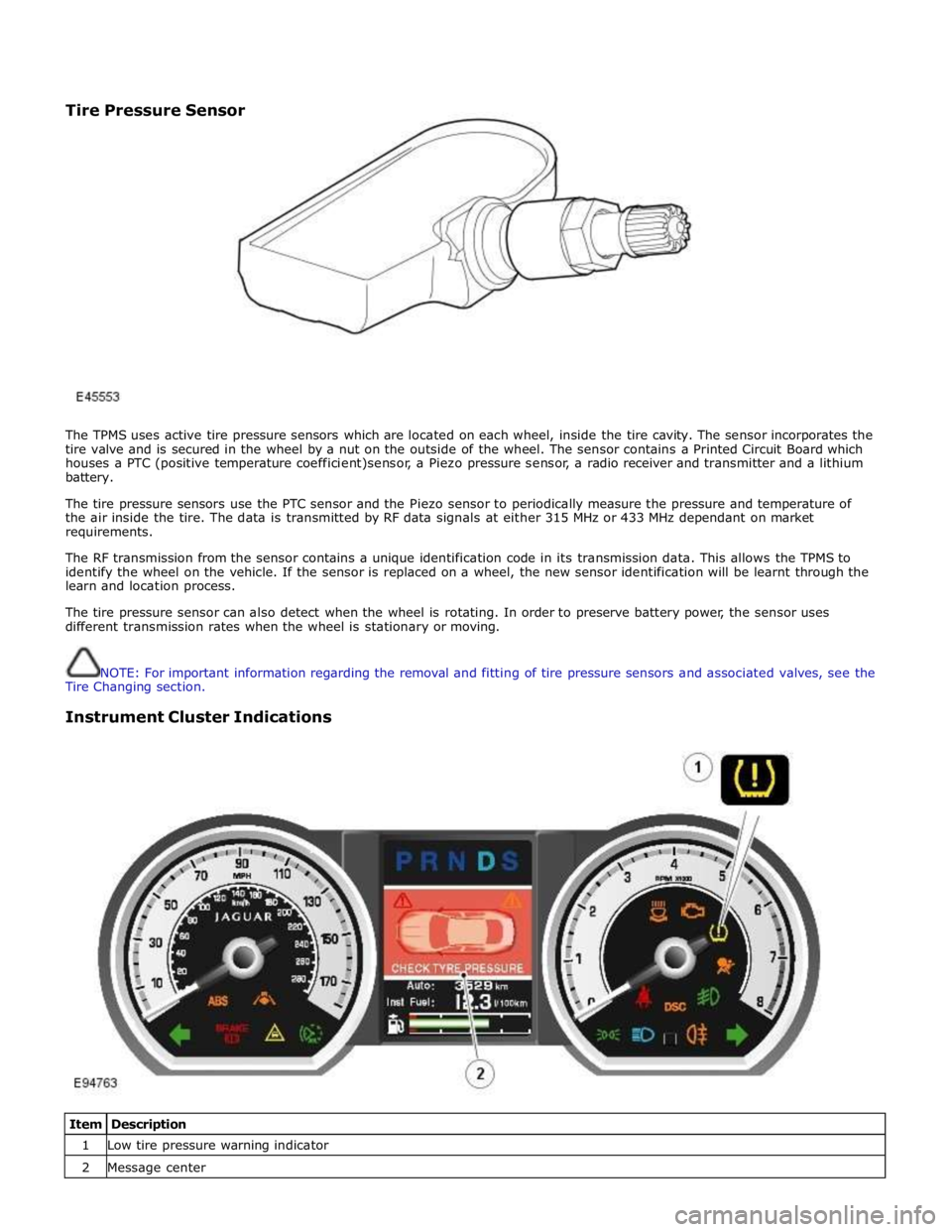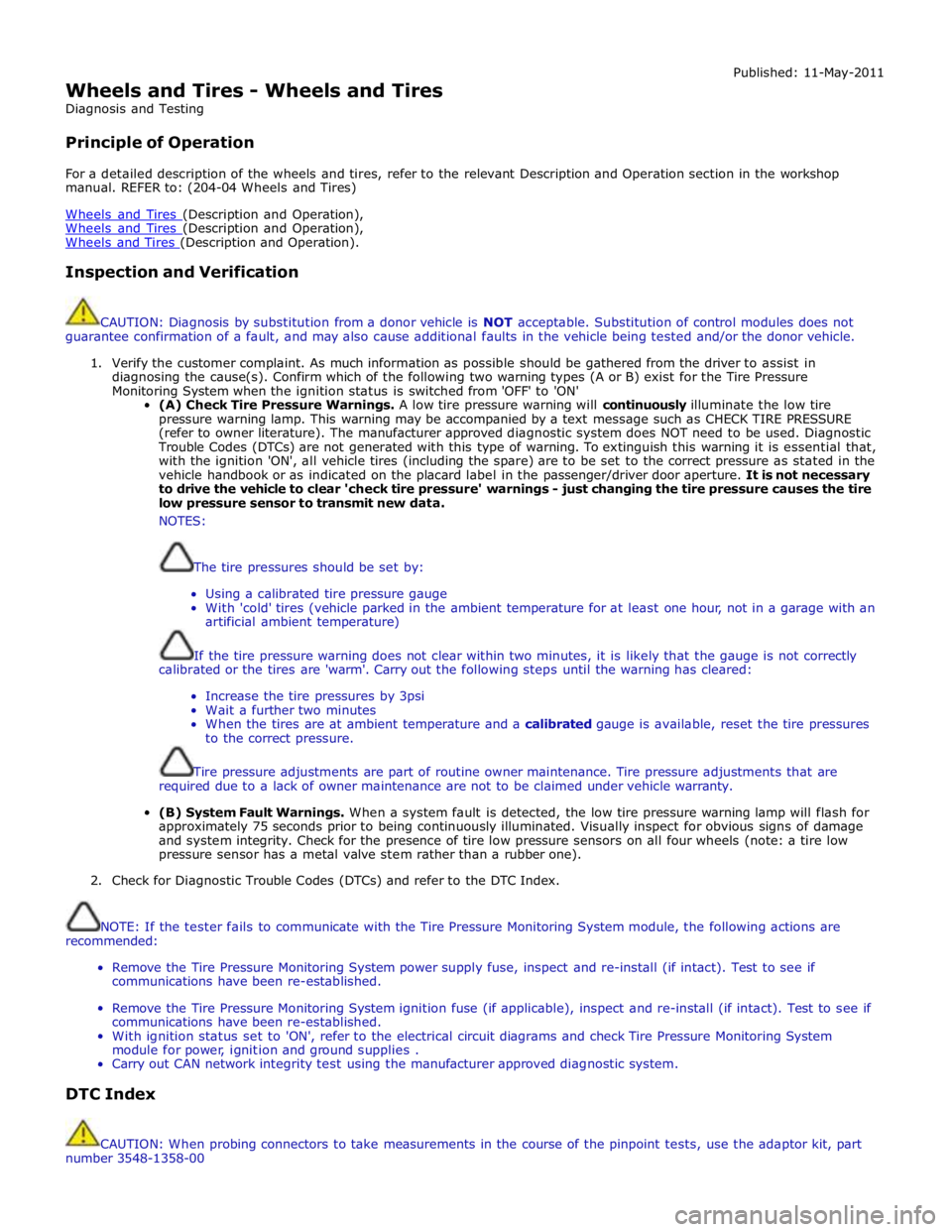sensor JAGUAR XFR 2010 1.G Workshop Manual
[x] Cancel search | Manufacturer: JAGUAR, Model Year: 2010, Model line: XFR, Model: JAGUAR XFR 2010 1.GPages: 3039, PDF Size: 58.49 MB
Page 440 of 3039

1 Tire valve and pressure sensor 2 Tire fitting/removal tool initial start position 3 High tire and bead tension area 4 Low tire and bead tension area When removing the tire, the bead breaker must not be used within 90 degrees of the tire valve in each direction on each side
of the tire.
When using the tire removal machine, the fitting arm start position must be positioned as shown in the tire changing
illustration for each side of the tire. The wheel can then be rotated through 180 degrees in a counter-clockwise direction. This
will relieve tension from the tire bead allowing the remaining 180 degrees of the tire to be manually pulled from the rim.
When refitting the tire, position the fitting arm as shown. Rotate the tire and take care that the bead on the low tension side
of the tire does not damage the sensor.
Run-Flat Tires
Run-flat tires are not available on vehicles from 2011MY.
TREAD Act - NAS Only
Vehicles supplied to the North American markets must comply with the legislation of the Transport Recall Enhancement,
Accountability and Documentation (TREAD) act. Part of the requirement of the TREAD act is for the vehicle to display a label
which defines the recommended tire inflation pressure, load limits and maximum load of passengers and luggage weight the
vehicle can safely carry. This label will be specific to each individual vehicle and will be installed on the production line. The
label is positioned on the driver's side 'B' pillar on NAS vehicles and the inside rear face of the LH door on Canadian
specification vehicles.
This label must not be removed from the vehicle. The label information will only define the specification of the vehicle as it
came off the production line. It will not include dealer or owner fitted accessory wheels and tires of differing size from the
original fitment.
If the label is damaged or removed for body repair, it must be replaced with a new label specific to that vehicle. A new label is
requested from Jaguar parts and will be printed specifically for the supplied VIN of the vehicle.
Tire Pressure Monitoring System (TPMS)
The Tire Pressure Monitoring System (TPMS) is a driver assistance system which assists the driver to maintain the tire
pressures at the optimum level. TPMS is standard fitment on NAS vehicles and an optional fitment in other markets. TPMS
Page 442 of 3039

Published: 11-May-2011
Wheels and Tires - Wheels and Tires - System Operation and Component Description
Description and Operation
Control Diagram
NOTE: A = Hardwired; F = RF Transmission; N = Medium speed CAN bus; W = LF Transmission
Item Description 1 Battery 2 Megafuse (250A) 3 CJB (central junction box) 4 RJB (rear junction box) 5 TPMS receiver 6 Tire pressure sensors
Page 443 of 3039

7 Initiators 8 TPMS module 9 Instrument cluster
Tire Pressure Monitoring System (TPMS) System Operation
The controlling software for the Tire Pressure Monitoring System (TPMS) is located within a Tire Pressure Monitoring System
Module. The software detects the following:
When the tire pressure is below the recommended low pressure value - under inflated tire.
The location of the tire on the vehicle that is below the recommended pressure.
Malfunction warning.
The TPMS system comprises:
Tire pressure monitoring system module located below the right-hand front seat.
Tire pressure receiver located near the gear shifter within the floor console.
Two front initiators positioned forward of the wheels and behind the fender splash shields.
Two rear initiators positioned rearward of the wheels and assembled on dedicated brackets located behind the fender
splash shields.
Four sensors, each sensor is integral with a tire valve and located within the tire; the space saver spare wheel is not
fitted with a sensor.
The four initiators are hard wired to the TPMS module. The initiators transmit 125 KHz Low Frequency (LF) signals to the tire
pressure sensors which respond by modifying the mode status within the Radio Frequency (RF) transmission. The 315 or 433
MHz RF signals are detected by the tire pressure receiver which is connected directly to the TPMS module. The received RF
signals from the tire pressure sensors are passed to the TPMS module and contain identification, pressure, temperature and
acceleration information for each wheel and tire.
The TPMS module communicates with the instrument cluster via the medium speed CAN bus to provide the driver with
appropriate warnings. The TPMS module also indicates status or failure of the TPMS or components.
Tire Location and Identification
The TPMS can identify the position of the wheels on the vehicle and assign a received tire pressure sensor identification to a
specific position on the vehicle, for example front left, front right, rear left and rear right. This feature is required because of
the different pressure targets and threshold that could exist between the front and rear tires.
The wheel location is performed automatically by the TPMS module using an 'auto-location' function. This function is fully
automatic and requires no input from the driver. The TPMS module automatically re-learns the position of the wheels on the
vehicle if the tire pressure sensors are replaced or the wheel positions on the vehicle are changed.
The TPMS software can automatically detect, under all operating conditions, the following:
one or more new tire pressure sensors have been fitted
one or more tire pressure sensors have stopped transmitting
TPMS module can reject identifications from tire pressure sensors which do not belong to the vehicle
two 'running' wheels on the vehicle have changed positions.
If a new tire pressure sensor is fitted on any 'running' wheel, the module can learn the new sensor identification automatically
through the tire learn and location process.
The tire-learn and location process is ready to commence when the vehicle has been stationary or traveling at less than 12
mph (20 km/h) for 15 minutes. This is known as 'parking mode'. The learn/locate process requires the vehicle to be driven at
speeds of more than 12 mph (20 km/h) for 15 minutes. If the vehicle speed reduces to below 12 mph (20 km/h), the learn
process timer is suspended until the vehicle speed increases to more than 12 mph (20 km/h), after which time the timer is
resumed. If the vehicle speed remains below 12 mph (20 km/h) for more than 15 minutes, the timer is set to zero and process
starts again.
Low Pressure Monitoring
The tire low pressure sensor transmits by RF (315 MHz or 433 MHz depending on market) signal. These signals contain data
which corresponds to tire low pressure sensor identification, tire pressure, tire temperature, acceleration and tire low pressure
sensor mode.
Each time the vehicle is driven, the tire pressure monitoring system module activates each LF antenna in turn. The
corresponding tire low pressure sensor detects the LF signal and responds by modifying the mode status within the RF
transmission.
The system enters 'parking mode' after the vehicle speed has been less than 20 km/h (12.5 miles/h) for 12 minutes. In parking
mode the tire low pressure sensors transmit a coded signal to the tire pressure monitoring system module once every 13
hours. If the tire pressure decreases by more than 0.06 bar (1 lbf/in²) the tire low pressure sensor will transmit more often as
pressure is lost.
As each wheel responds to the LF signal from the tire pressure monitoring system module, it is assigned a position on the
vehicle and is monitored for the remainder of that drive cycle in that position.
Page 445 of 3039

The TPMS uses active tire pressure sensors which are located on each wheel, inside the tire cavity. The sensor incorporates the
tire valve and is secured in the wheel by a nut on the outside of the wheel. The sensor contains a Printed Circuit Board which
houses a PTC (positive temperature coefficient)sensor, a Piezo pressure sensor, a radio receiver and transmitter and a lithium
battery.
The tire pressure sensors use the PTC sensor and the Piezo sensor to periodically measure the pressure and temperature of
the air inside the tire. The data is transmitted by RF data signals at either 315 MHz or 433 MHz dependant on market
requirements.
The RF transmission from the sensor contains a unique identification code in its transmission data. This allows the TPMS to
identify the wheel on the vehicle. If the sensor is replaced on a wheel, the new sensor identification will be learnt through the
learn and location process.
The tire pressure sensor can also detect when the wheel is rotating. In order to preserve battery power, the sensor uses
different transmission rates when the wheel is stationary or moving.
NOTE: For important information regarding the removal and fitting of tire pressure sensors and associated valves, see the
Tire Changing section.
Instrument Cluster Indications
Item Description 1 Low tire pressure warning indicator 2 Message center Tire Pressure Sensor
Page 446 of 3039

The warning indications to the driver are common on all vehicles fitted with TPMS. The driver is alerted to system warnings by
a low tire pressure warning indicator in the instrument cluster and an applicable text message in the message centre.
The TPMS module passes system status information to the instrument cluster on the medium speed CAN bus. The instrument
cluster converts this data into illumination of the warning indicator and the display of an appropriate message.
When the ignition is switched on, the warning indicator is illuminated for 3 seconds for a bulb check.
NOTE: If the vehicle is not fitted with the TPMS, the warning indicator will not illuminate.
The instrument cluster checks, within the 3 second bulb check period, for a CAN bus message from the TPMS. During this time
the TPMS performs internal tests and CAN bus initialization. The warning indicator will be extinguished if the TPMS module
does not issue a fault message or tire pressure warning message.
If a TPMS fault warning message is detected by the instrument cluster at ignition on, the warning indicator will flash for 72
seconds after the 3 second bulb check period and then remain permanently illuminated.
If a tire pressure warning message is detected by the instrument cluster at ignition on, the warning indicator will extinguish
briefly after the 3 second bulb check period, before re-illuminating to indicate a tire pressure warning.
The following table shows the warning indicator functionality for given events:
Event Instrument Cluster Indications Low pressure warning limit reached in one wheel
Warning indicator illuminated. 'CHECK TYRE PRESSURE' message displayed
and applicable tire highlighted on display. Low pressure warning limit reached in one or
more wheels in low speed mode (only if programmed or learning) Warning indicator illuminated. 'CHECK ALL TYRE PRESSURES' message
displayed. TPMS fault
Warning indicator flashes for 72 seconds and is then permanently
illuminated. The flash sequence repeats after ignition on cycle. 'TYRE
PRESSURE SYSTEM FAULT' message displayed. No transmission from a specific tire pressure
sensor or Specific tire pressure sensor fault Warning indicator flashes for 72 seconds and is then permanently
illuminated. The flash sequence repeats after ignition on cycle. 'TYRE NOT
MONITORED' message displayed. No transmission from more than one tire pressure
sensor or more than one tire pressure sensor
fault Warning indicator flashes for 72 seconds and is then permanently
illuminated. The flash sequence repeats after ignition on cycle. 'TYRE
PRESSURE SYSTEM FAULT' message displayed. CAN (controller area network) signals missing
Warning indicator flashes for 72 seconds and is then permanently
illuminated. The flash sequence repeats after ignition on cycle. 'TYRE
PRESSURE SYSTEM FAULT' message displayed. Vehicle enters high speed mode (only available in
certain markets) Warning indicator illuminated. 'TYRE PRESSURE LOW FOR SPEED' message displayed.
Page 447 of 3039

Wheels and Tires - Wheels and Tires
Diagnosis and Testing
Principle of Operation Published: 11-May-2011
For a detailed description of the wheels and tires, refer to the relevant Description and Operation section in the workshop
manual. REFER to: (204-04 Wheels and Tires)
Wheels and Tires (Description and Operation), Wheels and Tires (Description and Operation), Wheels and Tires (Description and Operation).
Inspection and Verification
CAUTION: Diagnosis by substitution from a donor vehicle is NOT acceptable. Substitution of control modules does not
guarantee confirmation of a fault, and may also cause additional faults in the vehicle being tested and/or the donor vehicle.
1. Verify the customer complaint. As much information as possible should be gathered from the driver to assist in
diagnosing the cause(s). Confirm which of the following two warning types (A or B) exist for the Tire Pressure
Monitoring System when the ignition status is switched from 'OFF' to 'ON'
(A) Check Tire Pressure Warnings. A low tire pressure warning will continuously illuminate the low tire
pressure warning lamp. This warning may be accompanied by a text message such as CHECK TIRE PRESSURE
(refer to owner literature). The manufacturer approved diagnostic system does NOT need to be used. Diagnostic
Trouble Codes (DTCs) are not generated with this type of warning. To extinguish this warning it is essential that,
with the ignition 'ON', all vehicle tires (including the spare) are to be set to the correct pressure as stated in the
vehicle handbook or as indicated on the placard label in the passenger/driver door aperture. It is not necessary
to drive the vehicle to clear 'check tire pressure' warnings - just changing the tire pressure causes the tire
low pressure sensor to transmit new data.
NOTES:
The tire pressures should be set by:
Using a calibrated tire pressure gauge
With 'cold' tires (vehicle parked in the ambient temperature for at least one hour, not in a garage with an
artificial ambient temperature)
If the tire pressure warning does not clear within two minutes, it is likely that the gauge is not correctly
calibrated or the tires are 'warm'. Carry out the following steps until the warning has cleared:
Increase the tire pressures by 3psi
Wait a further two minutes
When the tires are at ambient temperature and a calibrated gauge is available, reset the tire pressures
to the correct pressure.
Tire pressure adjustments are part of routine owner maintenance. Tire pressure adjustments that are
required due to a lack of owner maintenance are not to be claimed under vehicle warranty.
(B) System Fault Warnings. When a system fault is detected, the low tire pressure warning lamp will flash for
approximately 75 seconds prior to being continuously illuminated. Visually inspect for obvious signs of damage
and system integrity. Check for the presence of tire low pressure sensors on all four wheels (note: a tire low
pressure sensor has a metal valve stem rather than a rubber one).
2. Check for Diagnostic Trouble Codes (DTCs) and refer to the DTC Index.
NOTE: If the tester fails to communicate with the Tire Pressure Monitoring System module, the following actions are
recommended:
Remove the Tire Pressure Monitoring System power supply fuse, inspect and re-install (if intact). Test to see if
communications have been re-established.
Remove the Tire Pressure Monitoring System ignition fuse (if applicable), inspect and re-install (if intact). Test to see if
communications have been re-established.
With ignition status set to 'ON', refer to the electrical circuit diagrams and check Tire Pressure Monitoring System
module for power, ignition and ground supplies .
Carry out CAN network integrity test using the manufacturer approved diagnostic system.
DTC Index
CAUTION: When probing connectors to take measurements in the course of the pinpoint tests, use the adaptor kit, part
number 3548-1358-00
Page 448 of 3039

NOTES:
If the control module or a component is suspect and the vehicle remains under manufacturer warranty, refer to the
Warranty Policy and Procedures manual (section B1.2), or determine if any prior approval programme is in operation, prior to
the installation of a new module/component.
Generic scan tools may not read the codes listed, or may read only five digit codes. If this is the case, match the five
digits from the scan tool to the first five digits of the seven digit code listed to identify the fault (the last two digits give extra
information read by the manufacturer-approved diagnostic system).
When performing voltage or resistance tests, always use a digital multimeter (DMM) accurate to three decimal places,
and with an up-to-date calibration certificate. When testing resistance, always take the resistance of the DMM leads into
account.
Check and rectify basic faults before beginning diagnostic routines involving pinpoint tests.
If DTCs are recorded and, after performing the pinpoint tests, a fault is not present, an intermittent concern may be the
cause. Always check for loose connections and corroded terminals.
DTC Description Possible Cause Action C1A56-31
Left Front Tire Pressure
Sensor and Transmitter
Assembly-no signal
Missing, incompatible or
defective tire low pressure
sensor or radio frequency
receiver GO to Pinpoint Test F. C1A56-68
Left Front Tire Pressure
Sensor and Transmitter
Assembly-event information
Information only - vehicle
exposed to extreme
temperature environment
and/or tire low pressure
sensor low battery voltage
event No action required. C1A56-91
Left Front Tire Pressure
Sensor and Transmitter
Assembly-parametric
Tire low pressure sensor
has reported out of range
information for pressure,
temperature or acceleration Replace defective tire low pressure sensor. Refer to
the relevant section of the workshop manual. C1A56-93
Left Front Tire Pressure
Sensor and Transmitter
Assembly-no operation
No tire low pressure sensor
can be localized at this
position due to an initiator
or tire low pressure sensor
malfunction GO to Pinpoint Test G. C1A57-11
Left Front Initiator-circuit
short to ground
Left front initiator circuit is
short to ground GO to Pinpoint Test B. Refer to Pinpoint test B1 C1A57-12
Left Front Initiator-circuit
short to battery
Left front initiator circuit is
short to power GO to Pinpoint Test B. Go to Pinpoint test B2 C1A57-13
Left Front Initiator-circuit
open
Left front initiator circuit
open GO to Pinpoint Test B. Go to Pinpoint test B9 C1A58-31
Right Front Tire Pressure
Sensor and Transmitter
Assembly-no signal
Missing, incompatible or
defective tire low pressure
sensor or radio frequency
receiver GO to Pinpoint Test F. C1A58-68
Right Front Tire Pressure
Sensor and Transmitter
Assembly-event information
Information only - vehicle
exposed to extreme
temperature environment
and/or tire low pressure
sensor low battery voltage
event No action required.
Page 449 of 3039

DTC Description Possible Cause Action C1A58-91
Right Front Tire Pressure
Sensor and Transmitter
Assembly-parametric
Tire low pressure sensor
has reported out of range
information for pressure,
temperature or acceleration Replace defective tire low pressure sensor. refer to
the relevant section of the workshop manual. C1A58-93
Right Front Tire Pressure
Sensor and Transmitter
Assembly-no operation
No tire low pressure sensor
can be localized at this
position due to an initiator
or tire low pressure sensor
malfunction GO to Pinpoint Test G. C1A59-11
Right Front Initiator-circuit
short to ground
Right front initiator circuit
is short to ground GO to Pinpoint Test C. Go to Pinpoint test C1 C1A59-12
Right Front Initiator-circuit
short to battery
Right front initiator circuit
is short to power GO to Pinpoint Test C. Go to Pinpoint test C2 C1A59-13
Right Front Initiator-circuit
open
Right front initiator circuit
open GO to Pinpoint Test C. Go to Pinpoint test C9 C1A60-31
Left Rear Tire Pressure
Sensor and Transmitter
Assembly-no signal
Missing, incompatible or
defective tire low pressure
sensor or radio frequency
receiver GO to Pinpoint Test F. C1A60-68
Left Rear Tire Pressure
Sensor and Transmitter
Assembly-event information
Information only - vehicle
exposed to extreme
temperature environment
and/or tire low pressure
sensor low battery voltage
event No action required. C1A60-91
Left Rear Tire Pressure
Sensor and Transmitter
Assembly-parametric
Tire low pressure sensor
has reported out of range
information for pressure,
temperature or acceleration Replace defective tire low pressure sensor, refer to
the relevant section of the workshop manual. C1A60-93
Left Rear Tire Pressure
Sensor and Transmitter
Assembly-no operation
No tire low pressure sensor
can be localized at this
position due to an initiator
or tire low pressure sensor
malfunction GO to Pinpoint Test G. C1A61-11
Left Rear Initiator-circuit
short to ground
Left rear initiator circuit
short to ground GO to Pinpoint Test D. Go to Pinpoint test D1 C1A61-12
Left Rear Initiator-circuit
short to battery
Left rear initiator circuit
short to power GO to Pinpoint Test D. Go to Pinpoint test D2 C1A61-13
Left Rear Initiator-circuit
open
Left rear initiator circuit
open GO to Pinpoint Test D. Go to Pinpoint test D9 C1A62-31
Right Rear Tire Pressure
Sensor and Transmitter
Assembly-no signal
Missing, incompatible or
defective tire low pressure
sensor or radio frequency
receiver GO to Pinpoint Test F. C1A62-68
Right Rear Tire Pressure
Sensor and Transmitter
Assembly-event information
Information only - vehicle
exposed to extreme
temperature environment
and/or tire low pressure
sensor low battery voltage
event No action required. www.JagDocs.com
Page 450 of 3039

DTC Description Possible Cause Action C1A62-91
Right Rear Tire Pressure
Sensor and Transmitter
Assembly-parametric
Tire low pressure sensor
has reported out of range
information for pressure,
temperature or acceleration Replace defective tire low pressure sensor, refer to
the relevant section of the workshop manual. C1A62-93
Right Rear Tire Pressure
Sensor and Transmitter
Assembly-no operation
No tire low pressure sensor
can be localized at this
position due to an initiator
or tire low pressure sensor
malfunction GO to Pinpoint Test G. C1A63-11
Right Rear Initiator-circuit
short to ground
Right rear initiator circuit
short to ground GO to Pinpoint Test E. Go to Pinpoint test E1 C1A63-12
Right Rear Initiator-circuit
short to battery
Right rear initiator circuit
short to power GO to Pinpoint Test E. Go to Pinpoint test E2 C1A63-13
Right Rear Initiator-circuit
open
Right rear initiator circuit
open GO to Pinpoint Test E. Go to Pinpoint test E9 C1A64-68
Spare Wheel Tire Pressure
Sensor and Transmitter
Assembly-event information
Information only - vehicle
exposed to extreme
temperature environment
and/or tire low pressure
sensor low battery voltage
event No action required. C1A64-91
Spare Wheel Tire Pressure
Sensor and Transmitter
Assembly-parametric
Tire low pressure sensor
has reported out of range
information for pressure,
temperature or acceleration Replace defective tire low pressure sensor, refer to
the relevant section of the workshop manual. C1A64-93
Spare Wheel Tire Pressure
Sensor and Transmitter
Assembly-no operation
Missing, incompatible or
defective tire low pressure
sensor or radio frequency
receiver GO to Pinpoint Test H. C1D19-11
External Receiver Data
Line-circuit short to ground
Tire pressure monitoring
system radio frequency
receiver or data line circuit
is short to ground GO to Pinpoint Test A. C1D19-12
External Receiver Data
Line-circuit short to battery
Tire pressure monitoring
system radio frequency
receiver or data line circuit
is short to power GO to Pinpoint Test I. C1D19-87
External Receiver Data
Line-missing message
Radio Frequency reception
blocked
Tire pressure monitoring
system radio frequency
receiver faulty
Tire pressure monitoring
system radio frequency
receiver or data line
circuits open circuit
Missing, incompatible or
defective tire low pressure
sensors GO to Pinpoint Test J. U0010-88
Medium Speed CAN
Communication Bus-bus off
CAN bus fault Carry out CAN network integrity tests. Refer to the
electrical wiring diagrams and check CAN network for
short, open circuit. U0140-00
Lost communication with
body control module-no sub
type information
CAN bus fault
Central Junction Box fault Refer to the electrical wiring diagrams and check
Central Junction Box power and ground supplies for
short, open circuit. Carry out CAN network integrity
tests.
Page 465 of 3039

Measure the resistance between: C3MC39A, harness side C4MC43, harness side Pin 7 Pin 1 Is the resistance greater than 5 ohms?
Yes
REPAIR the high resistance circuit. This circuit contains
intermediate connector, C44-Y. For additional information, refer to
the wiring diagram. Clear the DTC and run an On Demand Self Test
(ODST) using the manufacturer approved diagnostic system to
confirm rectification.
No
INSTALL a new rear right hand low-frequency initiator. REFER to:
Tire Pressure Monitoring System (TPMS) Rear Antenna (204-04 Wheels and Tires, Removal and Installation).
PINPOINT TEST F : MISSING, INCOMPATIBLE OR DEFECTIVE RUNNING TIRE LOW PRESSURE SENSOR
OR RECEIVER TEST
CONDITIONS DETAILS/RESULTS/ACTIONS F1: CHECK FOR CORRECT WHEEL AND TIRE ASSEMBLY AND TIRE LOW PRESSURE SENSOR 1 Establish that a full size running wheel and tire assembly has a tire low pressure sensor installed. As a visual confirmation, a tire low pressure sensor has a metal valve stem rather than a rubber one and
cannot be installed to a mini/space saver spare wheel. Is a full size wheel and tire assembly with tire low pressure sensor installed?
Yes
GO to F2. No
Install the correct wheel and tire assembly or tire low pressure sensor, of correct frequency, in accordance
with that defined in the manufacturer approved diagnostic system new tire low pressure sensor
application. F2: CHECK FOR ADDITIONAL DTCS 1 Remove the Tire Pressure Monitoring System power supply fuse and re-install it. Clear DTCs and leave the vehicle stationary for 15 minutes, then drive it at a speed greater than 15.5 mph (25 kph)
continuously for at least 10 minutes.
(Note: If the vehicle speed drops below this value, the drive time to complete the test will need to be increased.)
The use of the manufacturer approved diagnostic system, and the datalogger signal ’Tire pressure
monitor system status – learn mode status’ will verify the completion of the test when the value returns
to ‘Inactive’. 2 Check for additional DTCs C1A5631, C1A5831, C1A6031, C1A6231, with identical time stamps. Have all four DTCs logged with identical time stamps in the tire pressure monitoring system module?
Yes
Replace the tire pressure monitoring system radio frequency receiver.
REFER to: Tire Pressure Monitoring System (TPMS) Receiver (204-04 Wheels and Tires, Removal and Installation).
No
GO to F3. F3: VERIFY THE POSITION OF THE DEFECTIVE TIRE LOW PRESSURE SENSOR 1 Check tire pressure monitoring system DTCs. Are any C1AXX31 DTCs logged?
Yes
Install the correct tire low pressure sensor, of correct frequency, in accordance with that defined in the
manufacturer approved diagnostic system new tire low pressure sensor application, to the position
identified by the logged DTC.
REFER to: Tire Low Pressure Sensor (204-04 Wheels and Tires, Removal and Installation). No
No further action is required.
(Note: The use of the manufacturer approved diagnostic system, and the datalogger signal ’Tire pressure monitor system status – learn completed successfully’ will verify the successful completion of the test.)
PINPOINT TEST G : LOCALIZATION FAILURE TEST
CONDITIONS DETAILS/RESULTS/ACTIONS G1: CHECK FOR ADDITIONAL DTCS 1 Check for additional DTCs: C1A5711, C1A5712, C1A5713. C1A5911, C1A5912, C1A5913, C1A6111, C1A6112, C1A6113, C1A6311, C1A6312, C1A6313. Are any of the DTCs listed above also logged?
Yes
Refer to the DTC Index and remedial actions.
No
GO to G2. G2: CHECK FOR ADDITIONAL DTCS